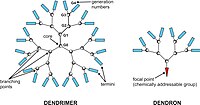
Photo from wikipedia
Background/Aims Direct sequencing is the gold standard for the detection of drug-resistance mutations in hepatitis B virus (HBV); however, this procedure is time-consuming, labor-intensive, and difficult to adapt to high-throughput… Click to show full abstract
Background/Aims Direct sequencing is the gold standard for the detection of drug-resistance mutations in hepatitis B virus (HBV); however, this procedure is time-consuming, labor-intensive, and difficult to adapt to high-throughput screening. In this study, we aimed to develop a dendron-modified DNA microarray for the detection of genotypic resistance mutations and evaluate its efficiency. Methods The specificity, sensitivity, and selectivity of dendron-modified slides for the detection of representative drug-resistance mutations were evaluated and compared to those of conventional slides. The diagnostic accuracy was validated using sera obtained from 13 patients who developed viral breakthrough during lamivudine, adefovir, or entecavir therapy and compared with the accuracy of restriction fragment mass polymorphism and direct sequencing data. Results The dendron-modified slides significantly outperformed the conventional microarray slides and were able to detect HBV DNA at a very low level (1 copy/μL). Notably, HBV mutants could be detected in the chronic hepatitis B patient sera without virus purification. The validation of our data revealed that this technique is fully compatible with sequencing data of drug-resistant HBV. Conclusions We developed a novel diagnostic technique for the simultaneous detection of several drug-resistance mutations using a dendron-modified DNA microarray. This technique can be directly applied to sera from chronic hepatitis B patients who show resistance to several nucleos(t)ide analogues.
Journal Title: Gut and Liver
Year Published: 2018
Link to full text (if available)
Share on Social Media: Sign Up to like & get
recommendations!